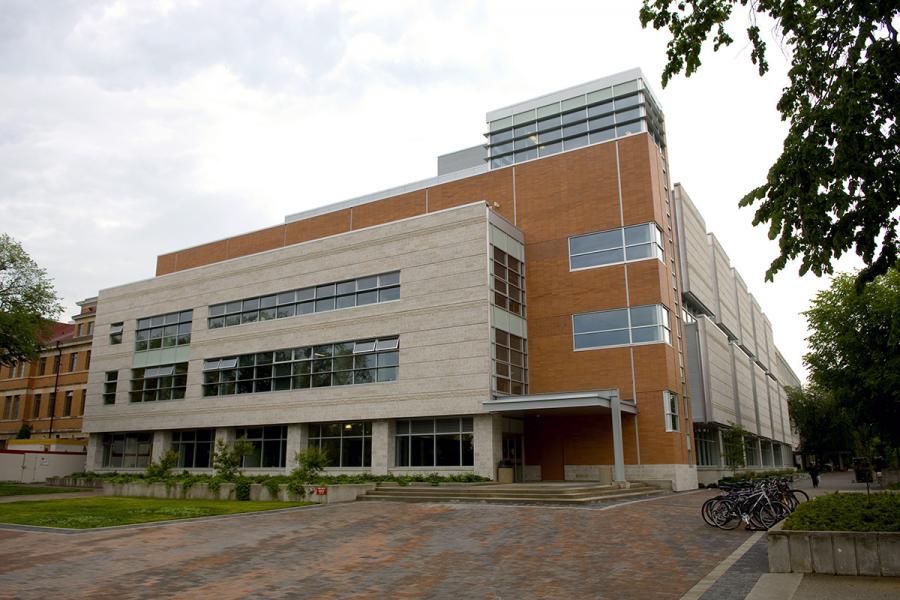Professor
Department of Civil Engineering
Room SP-427
Stanley Pauley Engineering Building
University of Manitoba (Fort Garry campus)
Winnipeg, MB R3T 5V6
The University of Manitoba campuses and research spaces are located on original lands of Anishinaabeg, Ininiwak, Anisininewuk, Dakota Oyate, Dene and Inuit, and on the National Homeland of the Red River Métis. More
University of Manitoba
Winnipeg, Manitoba Canada, R3T 2N2

Professor
Department of Civil Engineering
Room SP-427
Stanley Pauley Engineering Building
University of Manitoba (Fort Garry campus)
Winnipeg, MB R3T 5V6
Deep learning, structural dynamics, structural control, structural health monitoring, autonomous UAVs, automation, digital twin.
Dr. Cha received research grants totalling $1.2M from external granting agencies, such as CFI, NSERC, City of Winnipeg, and Research Manitoba. His extensive research activities in structural health monitoring (SHM) and structural control for seismic damage reduction have led to more than 100 peer-reviewed publications. These include Automation in Construction (IF: 10.517, top rank 1 in Civil Engineering), Computer-Aided Civil Infrastructure Engineering (CACIE) (IF: 10.066, top rank 2 in Civil Engineering), IEEE Transactions on Industrial Electronics (IF: 8.162), and Structural Health Monitoring (IF: 5.71).
His key scientific contribution is deep learning-based automated SHM with autonomous unmanned aerial vehicles (UAVs). He brought this topic to light with paper publications in top-ranking journals. Researchers, professors, scientists, students, and industry professionals from many different countries have shown a strong interest in this innovative topic since 2016 and have conducted numerous follow-up studies. His journal articles (Cha et al., 2017; Cha et al., 2018) published in CACIE were reported as lifetime topmost highly cited paper, and lifetime second most cited paper, and he was also reported as lifetime topmost highly cited author in this same journal. According to Google Scholar, he has received more than 9,200 citations. He was reported as a top 0.29% cited scientist within the civil engineering field and a top 0.35% cited scientist in all areas of science and engineering for single-year impact in the world in 2022 based on Stanford University analysis and Elsevier Data Repository.
Professor Young-Jin Cha received his PhD (2008) from Texas A&M University in the Department of Civil and Environmental Engineering, his M.Sc. (2004) from Yonsei University, and his B.Eng. (2002) from Kumoh National Institute of Technology. He started as a post-doctoral fellow (2009) at the City College of New York and then became a post-doctoral associate at the Massachusetts Institute of Technology (MIT) (2012). He joined the Department of Civil Engineering at the University of Manitoba (U of M) in 2014.
He received the 2021 Merit Award in the Research, Scholarly Work and Creative Activities category from the joint committee of the University of Manitoba and University of Manitoba Faculty Association. He also received an International Association of Advanced Materials Scientist Award, recognizing his contributions to smart materials and structures at the 2022 European Advanced Materials Congress. He was named in the 2005 Who’s Who in America, and has organized many symposiums at MIT and Caltech through Engineering Mechanics Institute conferences on deep learning and autonomous UAVs for SHM. He is serving as an academic editor in Structural Control & Health Monitoring. He also currently serves as a lead guest editor and associate editor in Engineering Report, Wiley, as associate editor in International Conference on Patten Recognition, and as an editorial board member and core peer reviewer in many top engineering journals associated with ASCE, IEEE, Elsevier, and Wiley. He is also serving and has served as a co-chair and technical/organizing committee member at many internal conferences
Dr. Cha is currently seeking graduate students. Please contact him for more information.
Cha, Y. J., Choi, W., & Büyüköztürk, O. (2017). Deep learning‐based crack damage detection using convolutional neural networks. Computer‐Aided Civil and Infrastructure Engineering, 32(5), 361-378.
Cha, Y. J., Choi, W., Suh, G., Mahmoudkhani, S., & Büyüköztürk, O. (2018). Autonomous structural visual inspection using region‐based deep learning for detecting multiple damage types. Computer‐Aided Civil and Infrastructure Engineering, 33(9), 731-747.
Chen, J. G., Wadhwa, N., Cha, Y. J., Durand, F., Freeman, W. T., & Buyukozturk, O. (2015). Modal identification of simple structures with high-speed video using motion magnification. Journal of Sound and Vibration, 345, 58-71.
Cha, Y. J., & Buyukozturk, O. (2015). Structural damage detection using modal strain energy and hybrid multiobjective optimization. Computer‐Aided Civil and Infrastructure Engineering, 30(5), 347-358.
Kang, D., & Cha, Y. J. (2018). Autonomous UAVs for structural health monitoring using deep learning and an ultrasonic beacon system with geo‐tagging. Computer‐Aided Civil and Infrastructure Engineering, 33(10), 885-902.
Beckman, G. H., Polyzois, D., & Cha, Y. J. (2019). Deep learning-based automatic volumetric damage quantification using depth camera. Automation in Construction, 99, 114-124.
Choi, W., & Cha, Y. J. (2019). SDDNet: Real-time crack segmentation. IEEE Transactions on Industrial Electronics, 67(9), 8016-8025.
Kang, D., Benipal, S. S., Gopal, D. L., & Cha, Y. J. (2020). Hybrid pixel-level concrete crack segmentation and quantification across complex backgrounds using deep learning. Automation in Construction, 118, 103291.
Kang, D. H., & Cha, Y. J. (2022). Efficient attention-based deep encoder and decoder for automatic crack segmentation. Structural Health Monitoring, 21(5), 2190-2205.
Ali, R., & Cha, Y. J. (2022). Attention-based generative adversarial network with internal damage segmentation using thermography. Automation in Construction, 141, 104412.
Ali, R., Kang, D., Suh, G., & Cha, Y. J. (2021). Real-time multiple damage mapping using autonomous UAV and deep faster region-based neural networks for GPS-denied structures. Automation in Construction, 130, 103831.
Wang, Z., & Cha, Y. J. (2021). Unsupervised deep learning approach using a deep auto-encoder with a one-class support vector machine to detect damage. Structural Health Monitoring, 20(1), 406-425.
For more information: